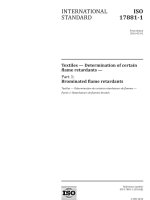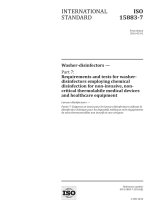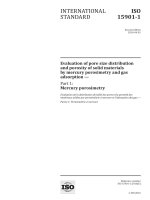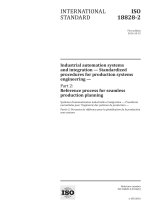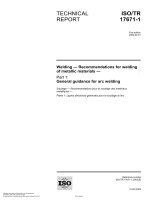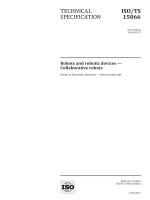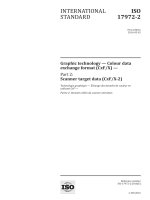Tiêu chuẩn iso tr 18130 2016
Bạn đang xem bản rút gọn của tài liệu. Xem và tải ngay bản đầy đủ của tài liệu tại đây (415.18 KB, 14 trang )
TECHNIC AL
REPORT
ISO/TR
18130
First edition
2 01 6-05-01
Dentistry — Screw loosening test
using cyclic torsional loading for
implant body/implant abutment
connection of endosseous dental
implants
Medecin e bucco-den taire — Essai de dévissage d’un e vis utilisan t un e
ch arge de torsion cyclique pour le corps d’im plan t/pilier im plan taire
des im plan ts den taires en do-osseux
Reference number
ISO/TR 1 81 3 0: 2 01 6(E)
©
ISO 2 01 6
ISO/TR 1813 0:2 016(E)
COPYRIGHT PROTECTED DOCUMENT
© ISO 2016, Published in Switzerland
All rights reserved. Unless otherwise speci fied, no part of this publication may be reproduced or utilized otherwise in any form
or by any means, electronic or mechanical, including photocopying, or posting on the internet or an intranet, without prior
written permission. Permission can be requested from either ISO at the address below or ISO’s member body in the country of
the requester.
ISO copyright office
Ch. de Blandonnet 8 • CP 401
CH-1214 Vernier, Geneva, Switzerland
Tel. +41 22 749 01 11
Fax +41 22 749 09 47
www.iso.org
ii
© ISO 2016 – All rights reserved
ISO/TR 1813 0:2 016(E)
Contents
Foreword
Page
........................................................................................................................................................................................................................................
Introduction
..................................................................................................................................................................................................................................
1
Scope
2
Normative references
.................................................................................................................................................................................................................................
......................................................................................................................................................................................
3 Termsanddefinitions
4
General principle
5
Test methods
.....................................................................................................................................................................................
.................................................................................................................................................................................................
.............................................................................................................................................................................................................
v
1
1
1
2
2
5 .1
Te s t co n d i ti o n . . . . . . . . . . . . . . . . . . . . . . . . . . . . . . . . . . . . . . . . . . . . . . . . . . . . . . . . . . . . . . . . . . . . . . . . . . . . . . . . . . . . . . . . . . . . . . . . . . . . . . . . . . . . . . . . . . . . . . . . . . . . . . . . . . . . . . . . . . . . . . . . . . . . . . . . . . . . . . . . . . . . . . . . . . . . . . . . . . . . . . . . . . . 2
5 .2
To rq u e m e te r . . . . . . . . . . . . . . . . . . . . . . . . . . . . . . . . . . . . . . . . . . . . . . . . . . . . . . . . . . . . . . . . . . . . . . . . . . . . . . . . . . . . . . . . . . . . . . . . . . . . . . . . . . . . . . . . . . . . . . . . . . . . . . . . . . . . . . . . . . . . . . . . . . . . . . . . . . . . . . . . . . . . . . . . . . . . . . . . . . . . . . . . . . . . 2
5 .3
P re p arati o n o f te s t s p e ci m e n s . . . . . . . . . . . . . . . . . . . . . . . . . . . . . . . . . . . . . . . . . . . . . . . . . . . . . . . . . . . . . . . . . . . . . . . . . . . . . . . . . . . . . . . . . . . . . . . . . . . . . . . . . . . . . . . . . . . . . . . . . . . . . . . . . . . . . . . . . . . . . . . . . . . 2
5 .4
I n i ti al s cre w re m o val to rqu e . . . . . . . . . . . . . . . . . . . . . . . . . . . . . . . . . . . . . . . . . . . . . . . . . . . . . . . . . . . . . . . . . . . . . . . . . . . . . . . . . . . . . . . . . . . . . . . . . . . . . . . . . . . . . . . . . . . . . . . . . . . . . . . . . . . . . . . . . . . . . . . . . . . . . . . 3
5 . 4. 1
5.5
5 .6
6
iv
.............................................................................................................
3
........................................................................................................................................... .............
3
5 .5 .2
To rq u e tran s d u ce r . . . . . . . . . . . . . . . . . . . . . . . . . . . . . . . . . . . . . . . . . . . . . . . . . . . . . . . . . . . . . . . . . . . . . . . . . . . . . . . . . . . . . . . . . . . . . . . . . . . . . . . . . . . . . . . . . . . . . . . . . . . . . . . . . . . . . . . . . . . . . . . . . . . . . . . . . . 4
5 .5 .3
P ro ce d u re . . . . . . . . . . . . . . . . . . . . . . . . . . . . . . . . . . . . . . . . . . . . . . . . . . . . . . . . . . . . . . . . . . . . . . . . . . . . . . . . . . . . . . . . . . . . . . . . . . . . . . . . . . . . . . . . . . . . . . . . . . . . . . . . . . . . . . . . . . . . . . . . . . . . . . . . . . . . . . . . . . . . . . . . . . . . . . . 4
E val u ati o n . . . . . . . . . . . . . . . . . . . . . . . . . . . . . . . . . . . . . . . . . . . . . . . . . . . . . . . . . . . . . . . . . . . . . . . . . . . . . . . . . . . . . . . . . . . . . . . . . . . . . . . . . . . . . . . . . . . . . . . . . . . . . . . . . . . . . . . . . . . . . . . . . . . . . . . . . . . . . . . . . . . . . . . . . . . . . . . . . . . . . . . . . . . . . . . . . . . . 5
Test report
Bibliography
P ro ce d u re . . . . . . . . . . . . . . . . . . . . . . . . . . . . . . . . . . . . . . . . . . . . . . . . . . . . . . . . . . . . . . . . . . . . . . . . . . . . . . . . . . . . . . . . . . . . . . . . . . . . . . . . . . . . . . . . . . . . . . . . . . . . . . . . . . . . . . . . . . . . . . . . . . . . . . . . . . . . . . . . . . . . . . . . . . . . . . . 3
Screw removal torque after cyclic torque test
5.5.1
Cyclic torque tester
...................................................................................................................................................................................................................
................................................................................................................................................................................................................................
© I S O 2 0 1 6 – Al l ri gh ts re s e rve d
5
6
iii
ISO/TR 1813 0:2 016(E)
Foreword
ISO (the International Organization for Standardization) is a worldwide federation of national standards
bodies (ISO member bodies). The work of preparing International Standards is normally carried out
through ISO technical committees. Each member body interested in a subject for which a technical
committee has been established has the right to be represented on that committee. International
organizations, governmental and non-governmental, in liaison with ISO, also take part in the work.
ISO collaborates closely with the International Electrotechnical Commission (IEC) on all matters of
electrotechnical standardization.
The procedures used to develop this document and those intended for its further maintenance are
described in the ISO/IEC Directives, Part 1 . In particular the different approval criteria needed for the
different types of ISO documents should be noted. This document was drafted in accordance with the
editorial rules of the ISO/IEC Directives, Part 2 (see www.iso.org/directives) .
Attention is drawn to the possibility that some of the elements of this document may be the subject of
patent rights. ISO shall not be held responsible for identifying any or all such patent rights. Details of
any patent rights identi fied during the development of the document will be in the Introduction and/or
on the ISO list of patent declarations received (see www.iso.org/patents) .
Any trade name used in this document is information given for the convenience of users and does not
constitute an endorsement.
For an explanation on the meaning of ISO speci fic terms and expressions related to conformity assessment,
as well as information about ISO’s adherence to the World Trade Organization (WTO) principles in the
Technical Barriers to Trade (TBT) see the following URL: www.iso.org/iso/foreword.html.
The committee responsible for this document is ISO/TC 106,
implants.
iv
Dentistry,
Subcommittee SC 8,
Dental
© ISO 2 01 6 – All rights reserved
ISO/TR 1813 0:2 016(E)
Introduction
Most endosseous dental implants currently marketed employ a dental implant body that is inserted
within the jaw bone and to which other components may be joined when constructing a prosthetic
superstructure. The connection between these components and the implant body should be sufficiently
rigid to resist vertical masticatory loads, which have a signi ficant torsional component. Endosseous
dental implants may, therefore, incorporate features to restrict rotation at the connection. If this is
insufficiently strong, then undesirable incidents, including screw loosening, distortion and fracture of
the linked components will occur. A cyclic torsional screw loosening test for the connection between
implant body and implant abutment would facilitate comparative evaluation.
© ISO 2016 – All rights reserved
v
TECHNICAL REPORT
ISO/TR 1813 0:2 016(E)
Dentistry — Screw loosening test using cyclic torsional
loading for implant body/implant abutment connection of
endosseous dental implants
1
Scope
T h i s Te c h n ic a l Re p o r t p ro vi de s g u ide l i ne s fo r a me tho d to de te r m i ne the e x te n t o f s c re w lo o s e n i n g o f the
metallic implant body/implant abutment joint of endosseous dental implants, such as two-part implants
or multi-part implants under cyclic torsional loading. This test is most appropriate for evaluating new
types of joints fixed using screw(s) and metallic connecting parts. This Technical Report provides a
protocol for torsional cyclic torque on an implant body/implant abutment joint, but its intended use is
fo r p re fab r i c ate d i mp l a n t b o d i e s , i mp l a n t ab u tme n ts a nd , i f ap p ro p r i ate , i mp l a n t co n ne c ti n g p a r ts th at
a re m ade o f me t a l l ic m ate r i a l s .
I t i s no t ap p l ic ab le to e n s u re the
in vivo
p e r fo r m a nc e o f e ndo s s e o u s de n ta l i mp l a n ts a nd i s no t de r i ve d
fro m o b s e r vatio n s o f cl i n i c a l fa i lu re s .
NOTE
2
This Technical Report is not intended for use with temporary abutments.
Normative references
The following documents, in whole or in part, are normatively referenced in this document and are
indispensable for its application. For dated references, only the edition cited applies. For undated
references, the latest edition of the referenced document (including any amendments) applies.
I S O 19 42 ,
Dentistry –Vocabulary
I S O 1 6 4 43 ,
Dentistry – Vocabulary for dental implants systems and related procedure
3Termsanddefinitions
For the purposes of this document, the terms and de finitions given in ISO 1942 and ISO 16443 and the
following apply.
3 .1
cyclic torque
repeated torsional force alternatively clockwise and counter clockwise
3 .2
screw loosening
decrease in screw removal torque relative to the removal torque when the abutment screw was first
i n s t a l le d
3.3
screw tightening torque
to rque
va lue
fo r
s c re w
re qu i re d
to
ti ghte n
the
i mp l a nt
ab u tme n t,
a nd
the
i mp l a n t
co n ne c ti n g
par t
if
appropriate, to the implant body as per speci fied by the manufacturer
3 .4
screw removal torque
torque value for screw required to deconstruct the connection between the implant body and the
i mp l a n t ab u tme nt, a nd the i mp l a n t c o n ne c ti n g p a r t i f ap p ro p r i ate
© I S O 2 0 1 6 – Al l ri gh ts re s e rve d
1
ISO/TR 1813 0:2 016(E)
3 .5
temporary abutment
implant abutment for temporary usage
4
General principle
body/implant abutment interface should be tested by applying a
cyclic alternating torsional load to the implant body and implant abutment clamped in the testing device.
The endurance properties of implant
Testing should be performed on finished devices or specimens that have an implant abutment joint
equivalent to the finished device (i.e. components that have undergone the same manufacturing
process as the device that is to be marketed) . I f the manufacturer intends the implant components to be
sterilized by the clinician prior to surgery, sterilization should be carried out before testing as speci fied
in the manufacturer’s instructions for use. However, if there is evidence that the speci fied sterilization
method has no signi ficant effect on the properties of all the materials of the specimens being tested,
sterilization is not necessary prior to testing. If so, this should be documented in the test report.
If a dental implant system to be tested consists of several types of implant abutments with the same
connecting interface, a s traight implant abutment having a metallic connecting interface should be
selected for tes ting.
NO TE
Angu lated implant abutments cannot be tes ted b ecaus e the central a xis of connec ted tes t s p ecimens
is not s traight.
5
Test methods
5.1
Test condition
Carry out the test at (25 ± 10) °C.
5.2
Torque meter
Use a torque meter with an accuracy of 0,3 N∙cm or less.
NO TE
5.3
An example of a torque meter is H DP-5
1)
manufactured by HIOS INC, Japan.
Preparation of test specimens
The implant abutment, and implant connecting part if appropriate, should be fixed on the implant body
using the speci fied/recommended screw at screw tightening torques stated by the manufacturer’s
ins tructions for use. The screw tightening torque should be applied using a torque meter. The ends of
the test specimens may be modi fied into shapes larger than the maximum diameter of implant body
and/or implant abutment to more easily clamp with the holders. An example of a test specimen is
illus trated in Figure 1 .
NO TE
At leas t s i x s p ecimens for each tes t according to 5 .4 and 5 . 5 are required to comp are the mean of the
screw removal torques after cyclic torque test with the mean of the initial screw removal torques.
HDP-5 is an example of a suitable product available commercially. This information is given for the convenience
of users of this document and does not constitute an endorsement by ISO of this product.
1)
2
© ISO 2 0 1 6 – All rights reserved
ISO/TR 1813 0:2 016(E)
Key
1
implant body
2
implant abutment
3
abutment screw
Figure 1 — Schematic of a test specimen
5.4
Initial screw removal torque
5.4.1
Procedure
The initial screw removal torque of si x specimens should be meas ured according to the following
procedure.
a) The implant abutment, and implant connecting part, if appropriate, should be fixed on the
implant body using the speci fied screw at screw tightening torques stated in the manufacturer’s
instructions for use. These implant components should be new ones that have never previously
been as sembled.
b) After 5 min, measure the screw removal torque by torque meter.
c)
C alculate the mean and s tandard deviation of initial screw removal torque from the obtained
values for the at leas t si x s pecimens .
5.5
5.5.1
Screw removal torque after cyclic torque test
Cyclic torque tester
The tes t device should have the following parts:
― specimen holders (the implant body and implant abutment should each be held at a maximum of
5 mm from the joint line between them);
― torque transducer;
― torsional cyclic driving device that can apply cyclic torque greater than 10 % of screw tightening
torque;
― torsional cyclic displacement transducer.
An example of a torsional tes ting device is illus trated in Figure 2 .
The central long a xes of the shafts of the torque transducer and torsional driving device should coincide.
© ISO 2 0 1 6 – All rights reserved
3
ISO/TR 1813 0:2 016(E)
Key
1
specimen holder
2
torque transducer
4
torsional cyclic driving device
torsional cyclic displacement transducer
5
lever arm
6
output of torsional displacement to recorder
7
output of torsional torque to recorder
8
implant body
9
implant abutment
3
Figure 2 — Example of testing device for cyclic torque test
5.5.2
Torque transducer
The accuracy of the torque transducer equipped in the cyclic torque tester (see 5 . 5 .1)
than ± 1 % of the maximum torque to be tested.
5.5.3
should be less
Procedure
a) The implant abutment, and implant connecting part, if appropriate, should be fixed on the implant
body using the speci fied screw at screw tightening torques as stated in the manufacturer’s
instructions for use. These implant components should be new ones that have never previously
been assembled.
b) After 5 min, clamp the retaining portions of the implant body and implant abutment of a test
specimen into the specimen holders of the testing device. The implant body and implant abutment
should each be held at a maximum of 5 mm from the joint line between them.
c) Apply cyclic torque (clockwise and counter clockwise) up to 10 % of the screw tightening torque
stated in the manufacture’s instruction to the implant abutment with the velocity of 10 degree per
minute. Repeat this cyclic torque up to 100 000 cycles.
4
© ISO 2 0 1 6 – All rights reserved
ISO/TR 1813 0:2 016(E)
d) When the specimen survives without deformation and/or fracture after 100 000 cycles, measure
the screw removal torque by torque meter. When the specimen does not survive, record the number
of cycles which it survives.
e) After the test, observe the wear and deformation of the implant body/connecting joint by a
microscope.
f)
At least six specimens should be tested.
g) Calculate the mean and standard deviation of the measured screw removal torque after cyclic
torque test of at least six specimens
NOTE 1 Implant body and implant abutment joint part are sealed by screw tightening and the part may not be
affected by corrosion during 100 000 times cyclic torque test (e.g. 1 d or 2 d).
NO TE 2
5.6
An example of the tes ting machine is AG-XR 2)
manufactured by Shimadzu Corporation, Japan.
Evaluation
Calculate the ratio of the mean initial screw removal torque to the screw tightening torque. Calculate the
ratio of the mean screw removal torque after cyclic torque test to the mean initial screw removal torque.
6
Test report
The test report should include at least the following information:
a) a reference to this Technical Report, i.e. ISO/TR 18130;
b) the identi fication of the employed test specimens, including the type of connection (internal
anti-rotation: taper- fit, notch- fit, hexagonal, etc.; external anti-rotation: hexagonal, etc.),
manufacturer(s) , part numbers and lot numbers of the tested parts, material(s) of the tested parts,
diameter and length of the implant body and implant abutment;
c) if applicable, the documented evidence that the speci fied sterilization method has no signi ficant
effect on the properties of all materials;
d)
the test method including the test condition, testing device, screw tightening torque applied to the
screws, cyclic torque, number of cycles, distance from the interface at which the components were
held and a drawing of the employed test specimens;
e) the results obtained, namely
1)
the initial screw removal torque and the ratio to the screw tightening torque,
2) the screw removal torque if the specimen survived 100 000 cycles and the ratio to the initial
screw removal torque,
3) if the specimen does not survive, the number of cycles which the testing specimen survives,
4)
the microscopic observation on deformed and/or fractured parts of test specimens.
AG-XR is an example of a suitable product available commercially. This information is given for the convenience
of users of this document and does not constitute an endorsement by ISO of this product.
2)
© ISO 2 01 6 – All rights reserved
5
ISO/TR 1813 0:2 016(E)
Bibliography
[1]
ISO 898-7,
Mech a n ica l
b o lts a n d scre ws with
[2]
ISO/TS 13498,
p ro p ertie s
of f
a sten ers
n o m in a l dia m eters 1
D en tistry
—
T
o rsio n
te st
mm
of
—
to
Pa rt
7:
T
o rsio n a l
te st
an d
m in im u m
to rq u e s
f
or
10 mm
im p la n t
b o dy/
co n n ectin g
p a rt
jo in ts
of
en do sseo u s
den ta l im p la n t s ystem s
[3]
[4]
ASTM F543-07, Standard specification and test methods for metallic medical bone screws
A ndersson B., O dman P., C arlsson L., B r å nemark P.I. A new Brånemark single tooth
abutment: handling and early clinical experiences.
1992, 7 (1)
pp. 105–111
B alfour A., & O ’B rien G.R. Comparative study of antirotational single tooth abutment.
1995, 73 (1) pp. 36–43
C ardoso M., Torres M.F., L ourenỗ o E.J., D e M oraes T elles D., Rodrigues R.C., Ribeiro
In t.
[5]
Ora l Im p la n ts Re s.
Guzaitis K.L., Knoernschild K.L., Viana M.A. Effect of repeated screw joint closing and
opening cycles on implant prosthetic screw reverse torque and implant and screw thread
morphology.
2011, 106 (3) pp. 159–169
Pro sth et.
D en t.
Khraisat A., H ashimoto A., N omura S., M iyakawa O. Effect of lateral cyclic loading on
abutment screw loosening of an external hexagon implant system.
2004, 91 (4)
pp. 326–334
Kim S.K., Koak J.Y., H eo S.J., Taylor T.D., Ryoo S., L ee S.Y. Screw loosening with interchangeable
J.
[9]
[10]
abutments in internally connected implants after cyclic loading.
Pro sth e t.
In t.
J.
Ora l
[12]
[13]
6
Ora l Im p la n ts Re s .
Im p la n t
D en t.
maintenance of retention screws and vertical mis fit of implant-supported crowns before and
after cycling.
2013, 28 (2) pp. 415–422
J.
Ora l Ma xillo f
a c.
Im p la n ts.
R angert B., Jemt T., Jö rneus L. Forces and moments on Brånemark implants.
1989, 4 (3) pp. 241–247
Yokoyama D., S hinya A., L assila L.V., G omi H., N akasone Y., Vallittu P.K., S hinya A.
In t.
J.
Ora l
Im p la n ts .
Framework design of an anterior fiber-reinforced hybrid composite fixed partial denture: a 3D
finite element study.
2009, 22 (4) pp. 405–412
In t.
[16]
Im p la n ts.
2006, 15 (4) pp. 427–435
Watanabe F. Torsion test at the interface between implant and abutment. Conference Program
of 13th Biennial Meeting of International College of Prosthodontists. Cape Town, South Africa.
10–13 Sep. 2009, pp. 172–173
J orge J.R., B arao V.A., D elben J.A., A ssuncao W.G. The role of implant/abutment on torque
Ma xillo f
a c.
[15]
Ma xillo f
a c.
screw torque loss with external hex and internal connection implant systems.
In t.
[14]
D en t.
2012, 27 (1) pp. 42–47
Yao K.T., K ao H.C., C heng C.K., Fang H.W., Yip S.W., H su M.L. The effect of clockwise and
counterclockwise twisting moments on abutment screw loosening.
2012,
23 (10) pp. 1181–1186
P iermatti J., Yousef H., Luke A., M ahevich R., Weiner S. An in vitro analysis of implant
Clin .
[11]
Im p la n ts.
R.F. Torque removal evaluation of prosthetic screws after tightening and loosening cycles: an in
vitro study.
2012, 23 pp. 475–480
J.
[8]
Ma xillo f
a c.
D en t.
Clin .
[7]
Ora l
J.
Pro sth et.
[6]
J.
J.
Pro sth o do n t.
J emt T., & P ettersson P. A 3-year follow-up study on single implant treatment.
21
(4) pp. 203–208
J.
D en t.
1993,
© ISO 2016 – All rights reserved
ISO/TR 1813 0:2 016(E)
[17 ]
G oodacre
implants.
[18]
[19]
J.
C.J., K an J.Y., Rungcharassaeng
Pro sth et.
D en t.
K.
Clinical complications of osseointegrated
1999, 81 (5 ) pp. 537–552
T heoharidou A., P etridis H .P., T zannas K., G arefis P. Abutment screw loosening in single-
implant restoration: a systematic review.
In t.
J.
Ora l Ma xillo f
a c.
Im pla n ts.
K atsuta Y., & Watanabe
F.
Abutment screw loosening of
body/abutment joint by cyclic loading test at the initial stage.
2008, 23 (4) pp. 681–690
endosseous dental implant
D en t.
Ma ter.
J.
2015 ,
3 4 (6)
pp. 896 –902
© ISO 2 01 6 – All rights reserved
7
ISO/TR 1813 0:2 016(E)
ICS 11.060.15
Price based on 7 pages
© ISO 2016 – All rights reserved


